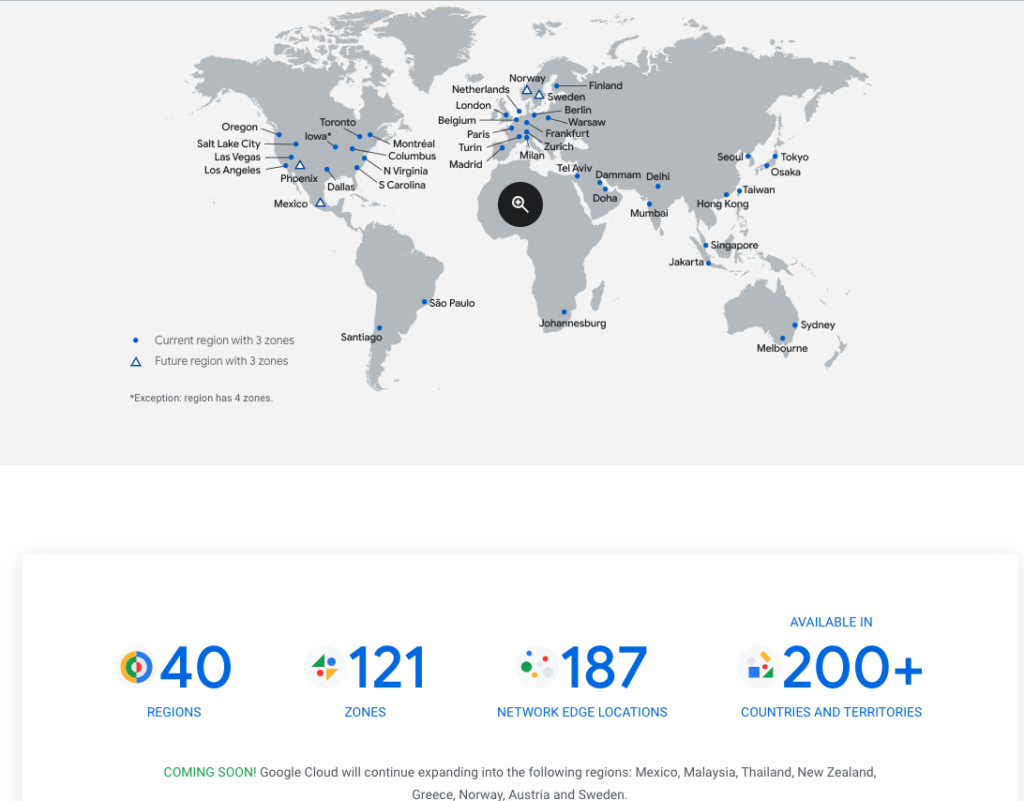Hey there, cloud enthusiasts! 👋 Ever wondered how Google Cloud Platform (GCP) delivers lightning-fast services worldwide? Let’s embark on an exciting journey to explore GCP’s global infrastructure, focusing on Regions and Zones. Ready to dive in? Let’s go! 🏊♂️
Please visit URL for the latest: https://cloud.google.com/about/locations

Global Map of GCP Regions and Zones (as of Oct 2024)
Understanding the Basics: Regions and Zones 🗺️
At the core of GCP’s robust infrastructure are Regions and Zones. Grasping these concepts is essential for anyone looking to harness the full potential of the cloud. Let’s break it down:
- Regions: These are specific geographic locations where GCP resources are hosted. Think of them as major cities in the cloud universe. 🏙️
- Zones: These are deployment areas within Regions, akin to neighborhoods within a city. Each Region typically contains three or more Zones. 🏘️
This hierarchical structure ensures high availability and resilience. If one Zone faces an issue, your services can continue running in another. Neat, right? 🤓
Regions and Zones | Google Cloud

Why Regions and Zones Matter 🌟
Understanding Regions and Zones isn’t just for techies—it’s crucial for optimizing performance, ensuring compliance, and enhancing user experience.
1. High Availability and Fault Tolerance 🔄
Deploying applications across multiple Zones or Regions minimizes downtime.
- Multi-Zone Deployment: Protects against Zone-specific failures.
- Multi-Region Deployment: Safeguards against regional outages.
Disaster Recovery Planning Guide | Google Cloud
2. Latency Reduction ⚡
Hosting your services closer to your users means faster response times.
- Proximity Matters: Choose Regions near your user base for optimal performance.
Network Latency Guidelines | Google Cloud
3. Regulatory Compliance 📜
Some data must reside within specific geographic boundaries due to legal requirements.
- Data Residency: Select Regions that comply with local laws and regulations.
Data Residency Compliance | Google Cloud

User Proximity and Latency

Decision Flowchart for Region Selection
GCP’s Global Network Backbone 🌐
GCP’s infrastructure is not just about data centers; it’s about how they’re interconnected.
- Private Global Fiber Network: One of the largest in the world, ensuring speedy data transfer. 🚄
- Subsea Cables: Undersea cables connect continents, enhancing global connectivity. 🌊
- Edge Points of Presence (PoPs): Bring content closer to users, reducing latency. 📍
Google’s Network Infrastructure | Google Cloud

Choosing the Right Region and Zone 🧭
Selecting where to deploy your resources can significantly impact your application’s performance and compliance.
1. Assess User Location 🌍
- Where are your users? Choose Regions closest to them.
2. Check Service Availability ✅
- Not all services are available in every Region.
- Service Availability Matrix for details.
3. Consider Costs 💰
- Pricing may vary by Region.
- Data Egress Charges: Moving data out of a Region can incur costs.
- Google Cloud Pricing
4. Compliance Requirements 🛡️
- Ensure the Region complies with any data sovereignty laws relevant to your industry.
Best Practices for Deployment 🛠️
To maximize the benefits of GCP’s global infrastructure, consider these strategies:
1. Use Managed Instance Groups 👥
- Automatically distribute workloads across Zones.
- Enable auto-scaling to handle traffic spikes.
Managed Instance Groups | Google Cloud
2. Implement Load Balancing ⚖️
- Global Load Balancers: Distribute traffic across multiple Regions.
- Regional Load Balancers: Manage traffic within a Region.
- Cloud Load Balancing | Google Cloud
3. Leverage Cloud CDN 📦
- Cache content at Edge PoPs to reduce latency.
Cloud CDN Overview | Google Cloud
4. Monitor and Optimize 📈
- Use Cloud Monitoring and Cloud Logging for insights.
- Regularly assess and adjust your deployment.
Operations Suite (formerly Stackdriver) | Google Cloud

Multi Zone Deployment
Real-World Applications 🌐
Let’s see how different industries benefit from GCP’s Regions and Zones.
E-commerce Platforms 🛒
- Challenge: High traffic during sales events.
- Solution: Use auto-scaling and multi-zone deployments for resilience.
E-commerce Solutions | Google Cloud
Streaming Services 🎥
- Challenge: Deliver content seamlessly worldwide.
- Solution: Deploy across multiple Regions and use Cloud CDN.
Media and Entertainment Solutions | Google Cloud
Financial Institutions 💳
- Challenge: Strict compliance and low latency.
- Solution: Select specific Regions to meet regulatory requirements.
Financial Services Solutions | Google Cloud

Multi-Region Deployment for Global Users
The Future is Here: Emerging Trends 🚀
Stay ahead by embracing the latest in cloud infrastructure.
Edge Computing 🌉
- Process data closer to where it’s generated.
- Reduces latency and bandwidth usage.
Hybrid and Multi-Cloud Strategies ☁️☁️
- Combine on-premises and cloud resources.
- Use multiple cloud providers for flexibility.
Anthos Multi-Cloud Platform | Google Cloud
Sustainability Initiatives 🌳
- GCP is committed to carbon-neutral operations.
- Deploying in certain Regions can reduce your carbon footprint.
Sustainability at Google Cloud

Edge Computing Integration
Tips for Getting Started 🎯
Ready to leverage GCP’s global infrastructure? Here’s how to begin:
- Identify Your Needs: Understand your application’s requirements.
- Plan Your Architecture: Use best practices for scalability and resilience.
- Test Deployments: Use GCP’s tools to simulate traffic and monitor performance.
- Stay Informed: Keep up with GCP updates and new Regions.
Getting Started with Google Cloud
Wrapping Up 🎁
By understanding and utilizing GCP’s Regions and Zones, you can:
- Enhance Performance: Deliver fast and reliable services to your users.
- Ensure Compliance: Meet legal requirements effortlessly.
- Optimize Costs: Pay for only what you need, where you need it.
So, are you ready to elevate your cloud game? 🌟 Start exploring GCP’s global infrastructure today and take your applications to new heights!
Happy Cloud Adventures! ☁️💙